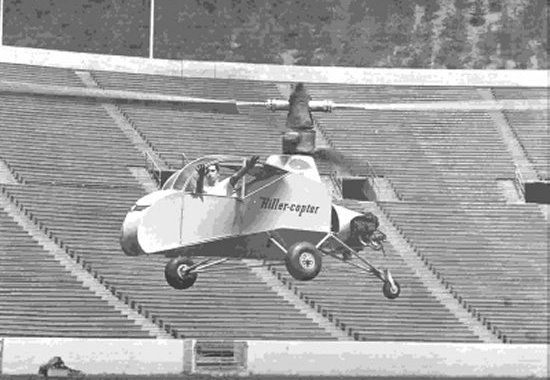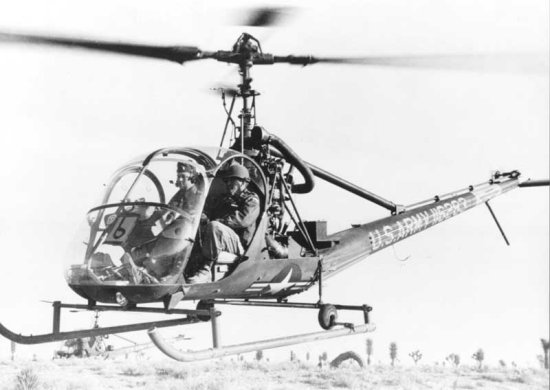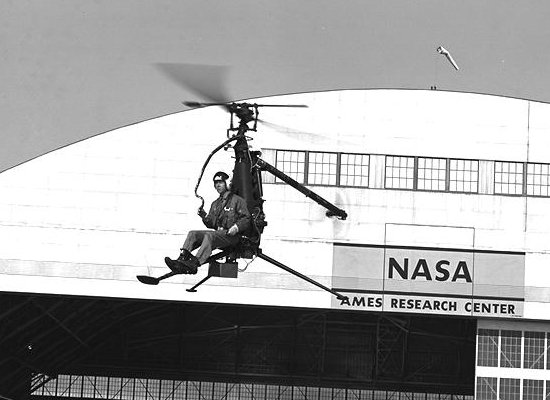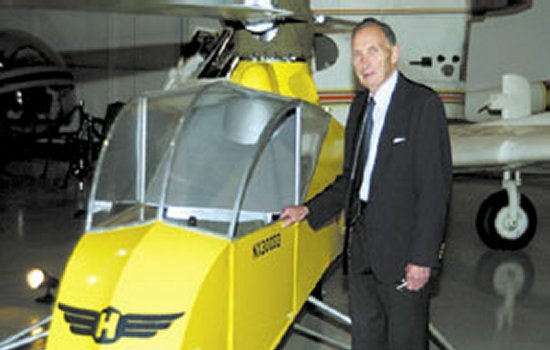|
||||||||||
|
|
||||||||||
|
||||||||||
|
|
||||||||||
The aerospace world lost one of its most remarkable members when the helicopter pioneer Stanley Hiller passed away on April 20 from complications due to Alzheimer's disease. Hiller was 81. Stanley Hiller, Jr., son of another aviation pioneer Stanley Hiller, Sr. (1888-1968), was born in San Francisco in 1924. Even as a young boy, Hiller, Jr. showed a prodigal talent for invention. He had learned to fly before the age of 10 and started his own business building miniature powered racecar models, capable of a remarkable 60 mph (95 km/h), at 12. By 17, Stanley's company Hiller Industries was producing no fewer than 350 of the models per month for local stores and earning $100,000 a year.
With the help of his father and some draftsman, Stanley Hiller, Jr. also invented a die-casting machine based on a cooling process that increased the strength of aluminum castings used in his Comet racecar. The invention proved so significant that Hiller, who was only a 16 year-old freshman in college at the time, was contracted by the US military to build aluminum parts for fighter planes!

This innovative spirit was soon turned to aviation, and Hiller was particularly fascinated by the accomplishments of Igor Sikorsky's experiments with helicopters. Upon reading an article about the complex methods Sikorsky was using the compensate for a helicopter's instabilities, the young Hiller announced to his father, "I have ideas about how to correct that." The 15 year-old then set about designing and building a co-axial helicopter that required no tail rotor and did away with the complex gearing of Sikorsky's machines.
Though Hiller entered college at the young age of 16, he became so obsessed with tje possibilities of rotorcraft that he left after just a year to pursue his dream of perfecting helicopters. At 17, he even traveled to Washington DC to present his ideas to defense officials and obtain funding to build a manned version of his co-axial design. By 1944, Stanley had succeeded in completing his XH-44 "Hiller-Copter" and conducted its first flight in August of that year. The feat is all the more remarkable considering that he had never flown a helicopter, nor even seen one, prior to his first flight. The XH-44's maiden voyage, in fact, marked the first flight of any helicopter in the western United States The flight at San Francisco’s Marina Green, now marked by an historic plaque, propelled the young Hiller to international attention despite his lack of any formal engineering training or college degree. The XH-44 earned its place in aerospace history and is now a permanent display at the Smithsonian National Air & Space Museum.
Based on his impressive early successes, Hiller and investors formed United Helicopters in 1945 hoping to capitalize on a post-war market in low-cost commuter helicopters for the general public. Though Hiller had abandoned his co-axial approach following a nearly fatal accident, he once again reinvented helicopter technology with his development of the "Rotormatic Control System." This new approach featured an amazingly simple rotor system with significantly fewer parts than a conventional rotor. Hiller's innovation was embodied in the Hiller 360, only the third helicopter to be certified for civil use in American history.

The popularity of the 360 made Hiller one of the dominant helicopter manufacturers of the 1950s, and his series of small, lightweight, low-cost utility helicopters that followed revolutionized aviation. By now renamed the Hiller Aircraft Company, Hiller's orders skyrocketed with the start of the Korean War that saw a massive demand for utility helicopters to perform numerous missions for the US Army. Perhaps the most recognized of his designs was the H-23 used primarily for medical evacuations as popularized by the television series MASH. The Army bought 1,200 of these ubiquitous machines.
Hiller joined Sikorsky, Bell, and Piasecki to become the world's dominant helicopter manufacturers of the 1950s, and the foursome developed the majority of vertical flight technologies that we still use today. Among Hiller's many impressive accomplishments were the incredibly compact XROE-1 Rotorcycle one-man helicopter, the Flying Platform, the Hornet with its ramjet-powered rotor, and the X-18 tilt-wing transport that helped pave the way for today's V-22 Osprey.

Hiller's dominance of the utility helicopter market remained strong until the 1960s when the Army launched its Light Observation Helicopter program to purchase 4,000 units for utility missions. Though most considered Hiller's design to be best of the contenders, the industry was stunned when the powerful company of Howard Hughes was allowed to enter the competition at the last-minute and went on to win the OH-6 Cayuse contract. The controversial decision doomed Hiller Aircraft and its founder quickly formed a merger with Fairchild to keep the company alive.
Shortly thereafter in 1968, Hiller left the aviation industry to form an entirely new business called Hiller Investment Company. Also known as The Hiller Group, the firm used successful management techniques to help failing companies turn around and become profitable again. Hiller took leadership roles in numerous companies and helped most of them substantially improve their productivity, market share, and profits. Having started his own business at 15, Stanley Hiller remained a remarkably successful and savvy businessman into his 70s when he finally retired.

It was only in his later years that Hiller returned to his first love of aviation and started the
Hiller Aviation Museum in San Carlos, California. The museum
stresses education and research and has become the largest of its kind in the United States. At the age of 78,
Stanley Hiller was commended for his many contributions to aerospace with the Smithsonian Institution's 2002
National Air and Space Museum Trophy for Lifetime Achievement. Considering the amazing life he led, there is no
doubt that Stanley Hiller is certainly deserving of this prestigious honor.
- answer by Joe Yoon, 30 April 2006
Read More Articles:


|
Aircraft | Design | Ask Us | Shop | Search |

|
|
| About Us | Contact Us | Copyright © 1997-2023 | |||
|
|
|||